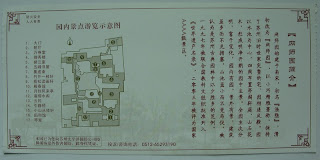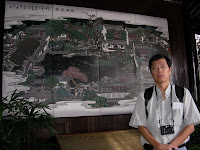Entrance fee to this garden is RMB30 for adult and children below 1.2m is free.
Entrance ticket front and back
One of the things I noticed about Suzhou is that its attraction sites are heavily linked and publicized. One could easily find the free guide booklet placed somewhere after the entrance. Like for this garden, we found this guide booklet.
The guide booklet gave quite a comprehensive description of the place in both English and Mandarin.
The guide booklet gave quite a comprehensive description of the place in both English and Mandarin.

Main entrance to this garden
Compared to the Lion Forest Garden 狮子林 this garden did not have as many tourists. However, one of the distinct difference that we found was that it has more Caucasians foreigners than the previous garden. I guess it is more of a backstreet attraction spot rather than the mainstream tourist site that brought loads of tourist in buses.
Garden signage (left) and a curious sign in one of the empty room at the side of the entrance (right)
When we entered the garden, the first thing that we came to was the main hall. This is according to the guide booklet called the Sedan-Chair Hall 轿厅.
Main entrance with a large map drawing of this garden
The theme of this hall, the sedan chair could be found at the right hand side of this hall.After the main hall is the Gateway with Richly Carved Earthen Ornamentation 砖雕门楼. One could not miss the unique stone gateway as shown in the photo captured below.
砖雕门楼
Followed by the main hall 大厅. This hall is a main part of the garden construction. In the past this place with glorious decoration was for the master of the garden working and entertaining the guests. It is also called the Hall of 10000 Volumes 万卷堂.Hall of 10000 Volumes 万卷堂
The Master-of-the-Nets Garden, or Wang Shi Yuan, was first laid out during the Sung Dynasty (960-1279) but was later abandoned. It was "rediscovered" in the 18th century by a retired official who restored the gardens. Like many Confucian scholar-officials, he preferred the peace of nature to the wrangling of Court life. He is said to have remarked that he would rather be a fisherman than a bureaucrat. This is the origin of the garden's name.Like the Humble Administrator's Garden, this garden is divided into three parts: an eastern section, or residential area; a central section, or main garden; and a western section, or the inner garden. This garden is, however, one of the smallest in Suzhou. It is only 1/10 of the size of the Humble Administrator's Garden.
The residential section of the garden is built with strict regard to the sumptuary regulations of the times. The front door is particularly notable for its ornamentation indicating the owner's courtly rank. Inside are numerous halls, each of which is connected separately to the central garden. All of the halls are placed on the standard north-south axis as is common in China.
The main garden has a large central pond (440 square meters) surrounded by a number of verandahs and walkways. In the pond is a small hexagonal pavilion of the type commonly found in other Suzhou gardens. Also in the pond is a smalls stone bridge called Yinjing Bridge (Leading to Serenity Bridge) 引静桥. Its width is less than one foot.
引静桥
Panorama View of Garden
One of the numerous rooms found in this garden. Can't really recalled this one as there are so many of them.Built on the site of the former Hall of 10,000 Volumes in the Southern Song Dynasty, the serene and consummate Five Peaks' Library 五峰书屋 is named after Li Bai's poem saying, "There are five great peaks to the south east of Mt.Lu, which seem to be golden lotus blooms cut out by the blue sky."
The Meditation Study 集虚斋 is a place where the owner used to cultivate his mind and achieve the union of individual soul and the spirit of the universe into one. 取《庄子·人间世》“惟道集虚,虚者,心斋也。The Daohe House 蹈和馆 was named according to a Chinese idiom “Lv Zhen Tao He" 履贞蹈和, which means “Peace and Auspicious" 和平安吉 in Chinese. The House is elegant and quite, and was used by its former owner as a place for feasts.


The Prunus Mume Pavilion 竹外一枝轩 is named after Su Shi's poem, saying, "There are thousands of shady trees in spring by the upper reaches of the river. A branch of prunus mume beyond the bamboo looks even better sideways."取宋代苏轼“江头千树春欲暗,竹外一枝斜更好”诗意而名。
We gone through exploring various parts of the garden.
We were at the bus stop waiting for our driver to pick us up.
When we were waiting for our driver at the entrance of the back street, one person came and asked me where the Master of Nets Garden was at. Obviously we were not the only person who had a hard time trying to find the garden. I guess the people in charge of promoting this garden should figure out a way to resolve this issue else it would not be able to get so many visitors.

































































































No comments:
Post a Comment